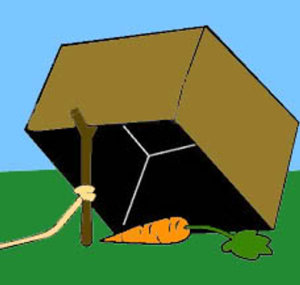
Basic survival skills
 We've
been thinking animal traps would be a good starting point for the possible
homesteading intern project we might be doing in the summer of 2012.
We've
been thinking animal traps would be a good starting point for the possible
homesteading intern project we might be doing in the summer of 2012.
Once the traps are in place
it will only take a matter of minutes to check on them.
I'm guessing there may be
enough rabbits to feed a small army while the first group begins to
carve out a homestead.
Want more in-depth information? Browse through our books.
Or explore more posts by date or by subject.
About us: Anna Hess and Mark Hamilton spent over a decade living self-sufficiently in the mountains of Virginia before moving north to start over from scratch in the foothills of Ohio. They've experimented with permaculture, no-till gardening, trailersteading, home-based microbusinesses and much more, writing about their adventures in both blogs and books.
Want to be notified when new comments are posted on this page? Click on the RSS button after you add a comment to subscribe to the comment feed, or simply check the box beside "email replies to me" while writing your comment.

Studies have been done by many of the states regarding domestic dogs and snares. Dogs, especially those broke to the leash and a collar simply sit down after being caught and are alive and well when you arrive. A snare set for a coyote will typically be too high for a cat; it will walk under the snare and never be caught. Same thing for a snare set for raccoons and dogs.
If you're worried about pets they make a relaxing locking mechanism that will relax as soon as the animal stops struggling. Many states such (I think Missouri, Pennsylvania and Wisconsin .. off the top of my head) only allow these relaxing locked snares, they're called cable restraints, to be used. They release domestic animals unharmed frequently.
The veteran snareman is able to set their snares to target a specific species and not harm others.